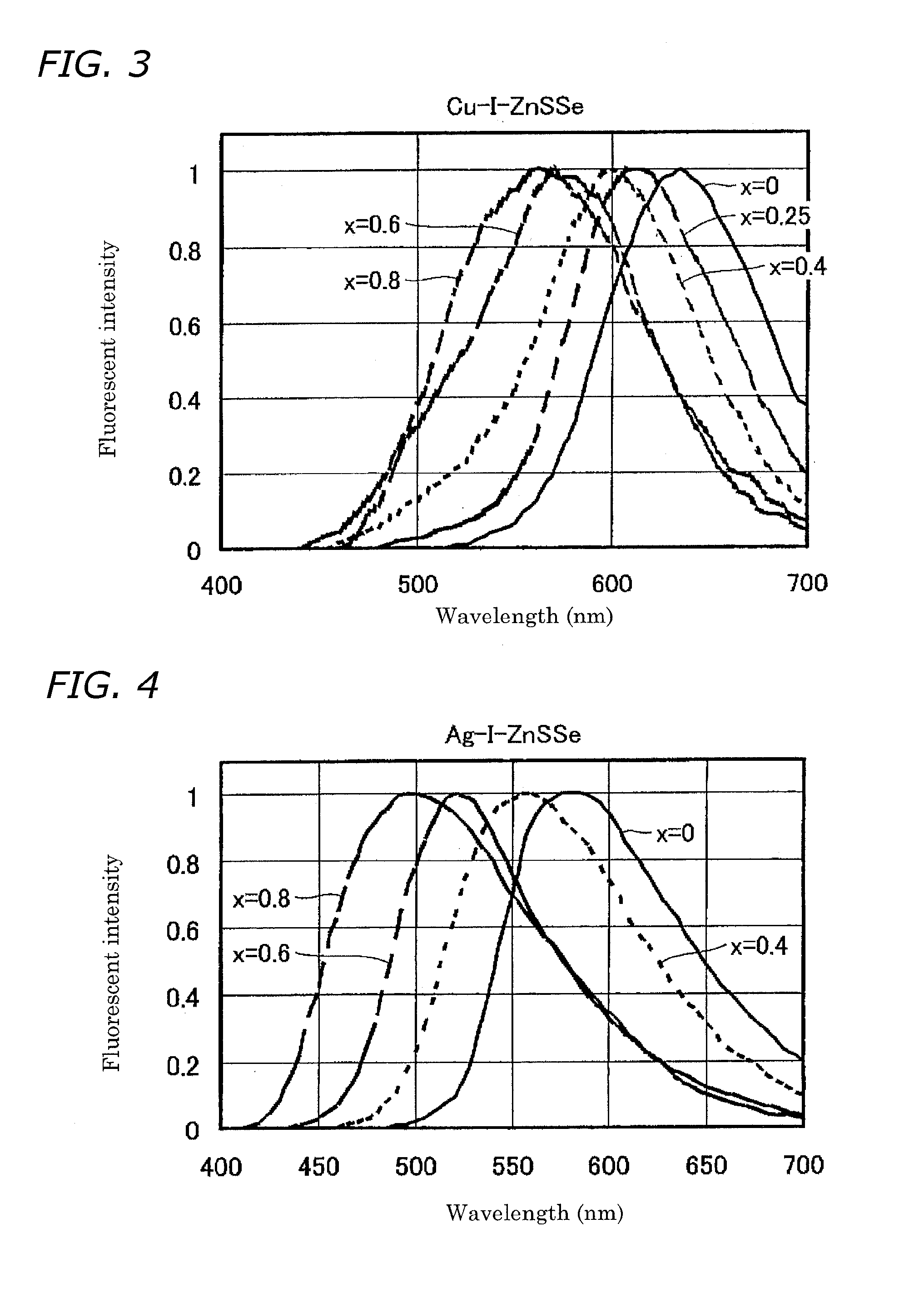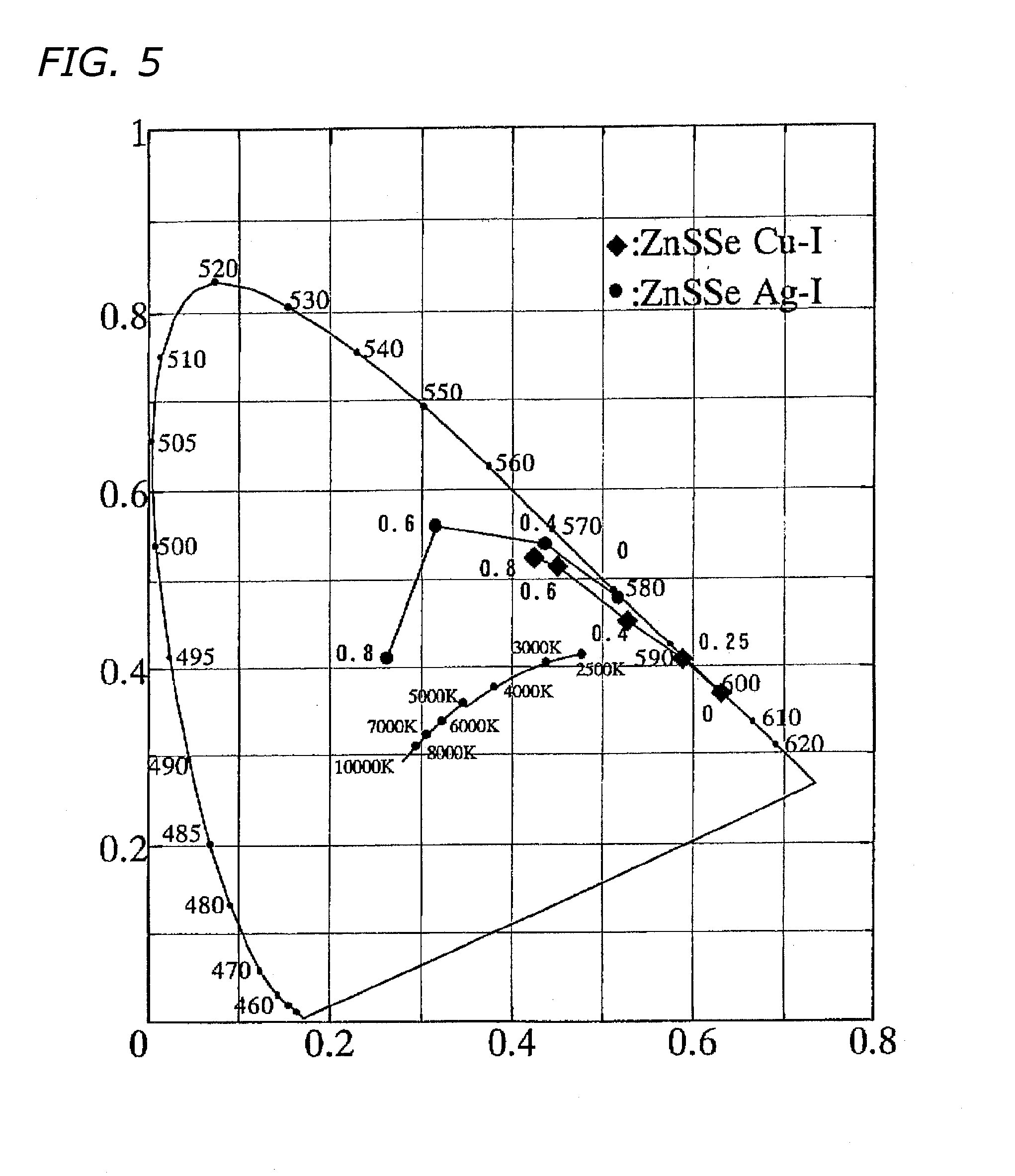White-Light Emitting Device, and Phosphor and Method of Its Manufacture
a technology of white light and phosphor, which is applied in the direction of discharge tube luminescnet screens, condensed vapors, sustainable buildings, etc., can solve the problems of short lifespan, inability to synthesize white light of a color temperature of choice, and prohibitive white light synthesizing, etc., to achieve high light-emitting efficiency, improve emission efficiency and temperature stability, and improve the effect of temperature stability
- Summary
- Abstract
- Description
- Claims
- Application Information
AI Technical Summary
Benefits of technology
Problems solved by technology
Method used
Image
Examples
embodiments
Embodiment 1
[0076] The white-light emitting device depicted in FIG. 9 was prepared. At first a ZnSSe crystal was grown using the iodine transport method and subsequently underwent heat treatment within a 1000° C. atmosphere in which Zn and Cu vapors were mixed, whereby a ZnS0.6Se0.4 crystal of predetermined composition (ZnS atomic fraction 0.6) was prepared. This phosphor corresponds to the rhombic mark for ZnS atomic fraction 0.6 nearby wavelength 570 nm on the chromaticity diagram, and is a yellow-light emitting phosphor. A ZnSSe plate of 250 microns thickness was cut out from the ZnS0.6Se0.4 crystal. Both sides of the ZnSSe plate were polished to a mirror-like finish, bringing the thickness down to 200 μm, and the polished plate was sliced into a 3 mm square to produce a ZnS0.6Se0.4 phosphor plate.
[0077] In addition, a blue LED chip of 450 nm emission wavelength, having an InGaN active layer, was readied. An Ag paste was employed to bond the LED chip onto a chip die (lead-frame...
embodiment 2
[0078] The white-light emitting device depicted in FIG. 10 was prepared. AZnSSe plate of 250 microns thickness was cut out from a ZnS0.6Se0.4 crystal (ZnS atomic fraction 0.6) at first being grown using the iodine transport method, and subsequently undergoing heat treatment within a 1000° C. atmosphere in which Zn and Ag vapors were mixed. This phosphor corresponds to the black-dot mark for ZnS atomic fraction 0.6 on the chromaticity diagram, and is a green-light emitting phosphor. Both sides of the ZnSSe plate were polished to a mirror-like finish, bringing the thickness down to 200 microns, and the polished plate was sliced into a 3 mm square to produce a ZnSSe phosphor plate (green phosphor: first phosphor).
[0079] In addition, a 400-micron square, 250-micron thick ZnS0.25Se0.75 phosphor plate (red phosphor: second phosphor) was prepared from a ZnS0.25Se0.75 crystal (ZnS atomic fraction 0.25) that was grown using the iodine transport method and subsequently underwent heat treatme...
PUM
 Login to view more
Login to view more Abstract
Description
Claims
Application Information
 Login to view more
Login to view more - R&D Engineer
- R&D Manager
- IP Professional
- Industry Leading Data Capabilities
- Powerful AI technology
- Patent DNA Extraction
Browse by: Latest US Patents, China's latest patents, Technical Efficacy Thesaurus, Application Domain, Technology Topic.
© 2024 PatSnap. All rights reserved.Legal|Privacy policy|Modern Slavery Act Transparency Statement|Sitemap



